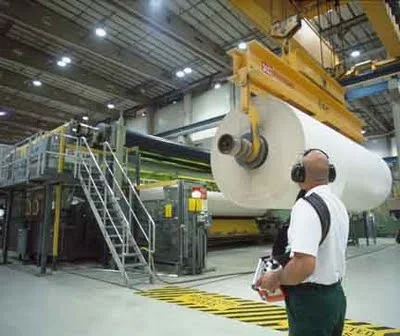I was told that paper machines will cost you somewhere in the range of 2 billion. Yeah that's right, more than any offset press on the market today. This is big business. These companies must have orders to make these machines pay for themselves or the close down. The folks at this mill said the machinery that grinds the logs used enough power to supply a small city. Add to that the fact they consume immense amounts of water and you have a seriously big budget operation.
The paper machine, as the video shows, consists of several basic elements.
1. Wood is ground to fiber.
2. Water and fiber are spread on wire screen (fourdrinier table)
3. Gradually moved through a dryer.
3. Coating is applied.
4. Roll is made.
Paper Making Starts With Selecting Trees
This whole process starts in selecting the trees. For the paper that was being produced in this video, a mixture of long and short fibers were used. The longer fibers from evergreens give the paper its strength, while the shorter fibers from hardwoods give it the bulk and opacity. Together they give the paper the necessary properties for offset presses. The paper being made here is for a printer in Israel.
What paper manufacturers hate is when people throw plastic into a recycle bin. The paper machines do not like it and when it gets to the press it causes hickeys.
The Paper Machine Itself
At the fourdrinier table, a mixture of 99% waste and 1% paper fiber is metered out onto a fine screen. By means of gravity, the water falls below. I was allowed to go up and take a close look. Below this table it was like a river. No wonder paper mills must be located on a river. They use millions of gallons of water a day in the process.
 |
| How paper looks after being super calendered. |
Custom Made
The paper being made was being shipped to Israel of all places and it was being custom made for the customer. A certain amount of gloss was being added and it was super-calendered to a specific caliper. This squishes the fibers and makes the paper nice and dense. If the order is large enough, offset printers can specify what final qualities they would like the paper to have based on the ink or the process they use.
Lastly, I encourage you to take a tour yourself. These paper mills are set up to have tour guides and of the three that I have been to, they all did it for free. So check out where the nearest paper mill is to you and take another pressman and learn a little more about what offset printing is all about!

Comments
Post a Comment